Monuments are a defining aspect of Rajasthani culture, heritage, and architecture; and for that matter everything Rajasthan. These majestic structures bestow such an unparalleled grandeur to the state that they easily become the envy of all other states in India. Five monuments from Rajasthan have recently been recommended to UNESCO for world heritage status. Below we make an attempt to appreciate the grandiosity of these five truly amazing structures:
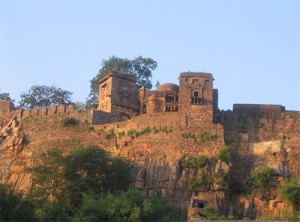 Ranthambore Fort
Ranthambore Fort
A formidable structure situated within the bounds of Ranthambore National Park, the Ranthambore Fort has been a focal point of several major developments in the history of Rajasthan. It is situated near Sawai Madhopur town in Rajasthan and is known for the glory and valour of the brave king Hammir Dev of Chauhan dynasty. Situated atop a hill, the fort offers a panoramic view of the National Park. This fortress was constructed in 944 AD by Nagil Jats. Strategically located, it comprises massive gates, lofty walls, tanks, and temples. The only entry to the fort is through these lofty gates that encompasses so many defense mechanisms. Inside the fort, there are three Hindu temples dedicated to Ganesh, Shiva, and Ramlalaji constructed in the 12th and 13th centuries from red Karauli stone. There is also a Jain temple of Lord Sumatinath (5th Jain Tirthankar) and Lord Sambhavanath.
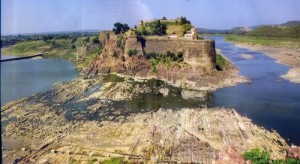 Gagron Fort (Jhalawar Fort)
Gagron Fort (Jhalawar Fort)
The Gagron Fort in Jhalawar is great embodiment of Rajasthani architecture in terms of design, structure and strategy. Add to this the charismatic stories of Rajput chivalry. It is the only fort which is surrounded by water on all four sites. It is surrounded by the Ahu and Kali Sindh rivers on three sides. The fourth is a moat: a ditch filled with water to protect the fort against any infiltration and assault. The fort is hence known as ‘Jaldurg’. The foundation of this magnificent fort was laid around 7th or 8th century AD. It served as a capital of Khichi Chauhans. Outside the fort there is the mausoleum of a Sufi saint, Mitte Shah, where a fair is organised every year during the Islamic month of Ramzan.
Chittorgarh Fort
The Chittorgarh Fort is the epitome of 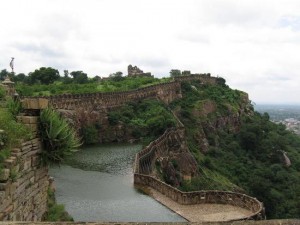 Rajput pride, romance and gallantry. The largest fort in the country (in terms of area), the Chittorgarh Fort is viewed as the ‘Pride of Rajasthan’. It is perched atop a 180 metre high hillock and is spread over a mammoth area of 700 acres, 40 percent of which is made up by water bodies. The fort is a treasure trove of history and offers a wonderful insight into the life of Rajput rulers, for whom their honour mattered most. The fort is 180 metre tall and occupies an area of 700 acres and built by the Mauryans in 7th century AD. According to a popular legend, it is said the Bhima of the Pandavas built the fort. The fort is approached through seven huge gateways or ´pols´, which are guarded by watch tower and massive iron spiked doors.
Rajput pride, romance and gallantry. The largest fort in the country (in terms of area), the Chittorgarh Fort is viewed as the ‘Pride of Rajasthan’. It is perched atop a 180 metre high hillock and is spread over a mammoth area of 700 acres, 40 percent of which is made up by water bodies. The fort is a treasure trove of history and offers a wonderful insight into the life of Rajput rulers, for whom their honour mattered most. The fort is 180 metre tall and occupies an area of 700 acres and built by the Mauryans in 7th century AD. According to a popular legend, it is said the Bhima of the Pandavas built the fort. The fort is approached through seven huge gateways or ´pols´, which are guarded by watch tower and massive iron spiked doors.
Amber Fort
Amber Fort is located in the small town of Am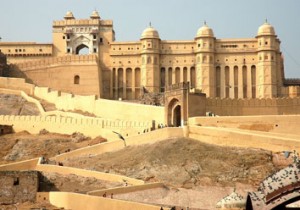 er, 11 km away from the ‘Pink City’ Jaipur. A principal tourist attraction from Jaipur, it was constructed by Raja Man Singh I and is situated on top of a hill, overlooking the Maota Lake. The fort is divided into four main sections each with its own entry gate and courtyard. It was the home of Rajput royalty before the city of Jaipur came into existence and also served their defence needs. Within its mighty walls, the fort houses a number of breathtaking palaces, halls, gardens, and temples. The elaborate mirror work also amplifies the grandeur. Jai Mandir is a famous temple in the fort which has Sheesh Mahal, a beautiful hall of mirrors that are so artistically set that even a tiny ray of light gets reflected in the mirrors and illumines the hall dazzlingly.
er, 11 km away from the ‘Pink City’ Jaipur. A principal tourist attraction from Jaipur, it was constructed by Raja Man Singh I and is situated on top of a hill, overlooking the Maota Lake. The fort is divided into four main sections each with its own entry gate and courtyard. It was the home of Rajput royalty before the city of Jaipur came into existence and also served their defence needs. Within its mighty walls, the fort houses a number of breathtaking palaces, halls, gardens, and temples. The elaborate mirror work also amplifies the grandeur. Jai Mandir is a famous temple in the fort which has Sheesh Mahal, a beautiful hall of mirrors that are so artistically set that even a tiny ray of light gets reflected in the mirrors and illumines the hall dazzlingly.
Kumbhalgarh Fort
Kumb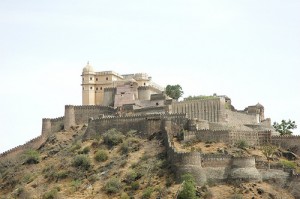 halgarh is an ancient Mewar bastion that stands majestically amidst a picturesque landscape in the district of Rajsamand in Southern Rajasthan. Situated just 82 km towards the Northeast of Udaipur, the tourism capital of Southern Rajashtan, the fort was erected by Rana Kumbha (hence the name Kumbhalgarh) in the 15th century AD. From the top of the fort, one gets a bird-eye’s view of the countryside. Encircled by thirteen elevated mountain peaks, the fort is constructed on the topmost ridges around 1,914 meters above sea level. The wall fortifying the fort is 36 km and this makes it the second longest wall in the world after the Great Wall of China. The huge complex of the Fort has numerous palaces, temples, and gardens making it all the more magnificent.
halgarh is an ancient Mewar bastion that stands majestically amidst a picturesque landscape in the district of Rajsamand in Southern Rajasthan. Situated just 82 km towards the Northeast of Udaipur, the tourism capital of Southern Rajashtan, the fort was erected by Rana Kumbha (hence the name Kumbhalgarh) in the 15th century AD. From the top of the fort, one gets a bird-eye’s view of the countryside. Encircled by thirteen elevated mountain peaks, the fort is constructed on the topmost ridges around 1,914 meters above sea level. The wall fortifying the fort is 36 km and this makes it the second longest wall in the world after the Great Wall of China. The huge complex of the Fort has numerous palaces, temples, and gardens making it all the more magnificent.

Facebook comments: ManaHotels